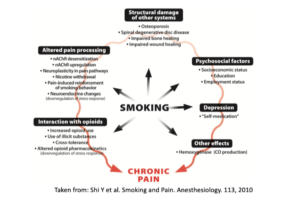Some patients report they smoke more because they have spine pain or anxiety. Studies have shown that smokers increase their cigarette consumption when their pain increases. 42% of persons experiencing medically unexplained pain in the last year smoke. 54% of treatment-seeking chronic pain patients smoke. Furthermore, these smokers tend to have more maladaptive pain behaviors, including decreased activity, increased medication reliance and greater emotional distress. Other articles suggest that chronic pain patients smoke due to depression and anxiety, partially from their pain. Tobacco smoking is one of the most preventable causes of sickness and death in the world. The additive property of nicotine is so intense that fewer than 10% of people trying to quit remain tobacco-free after 1 year. We all have natural opioid receptors in our brains. After all, we make our own endogenous opioids for analgesia and reward. Nicotine binds to these opioid receptors, called the Mu (μ) receptor.
Mu- opioid receptors have been found to vary in certain conditions. Major depression, anxiety, schizophrenia and drug addiction have been shown to change the Mu receptors in the brain. Smoking is recently also been associated with changes in these receptors. Smoking globally decreases Mu- opioid receptors by 8-14% in pain and reward centers of the brain, such as the amygdala, striatum, and insula. Likely, routine smoking causes nicotine to bind the Mu receptors or induces endogenous opioid release. Either way, this leads to a decrease in the receptors. Essentially, smoking may overactivate the brain’s opioid system causing it to shut down a bit.
Downregulating Mu- opioid receptors paradoxically leads to more pain. Since there are fewer functioning opioid receptors in the brain, pain may be more severe and medications used to treat pain may not work as well. Interestingly, postmenopausal women may have even fewer opioid receptors than in similar aged men, due to their hormonal state. Therefore older women who smoke may be at the greatest risk.
References
Kantonen T et al. Interindividual variability and lateralization of μ-opioid receptors
in the human brain. NeuroImage, 2020
Shi Y et al. Smoking and Pain. Anesthesiology. 113, 2010








